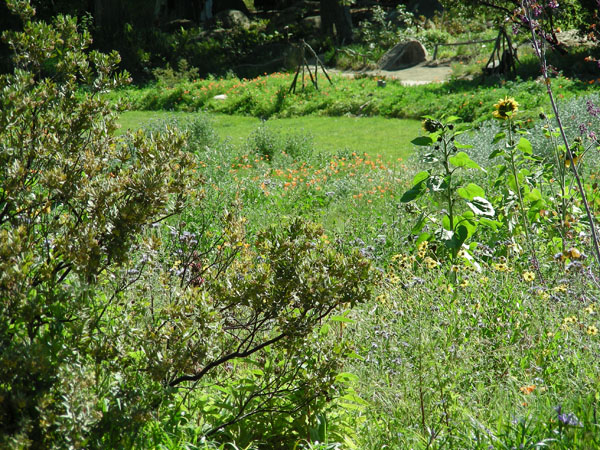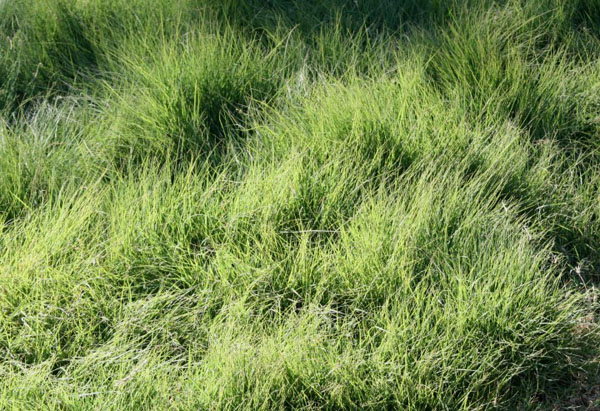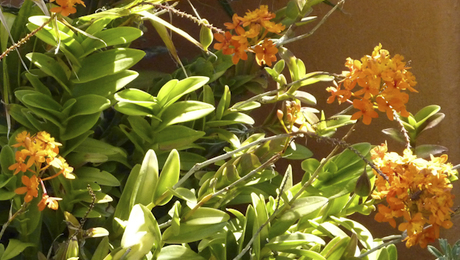
Photo/Illustration: Billy Goodnick

Photo/Illustration: Billy Goodnick




Photo/Illustration: Billy Goodnick

Photo/Illustration: Billy Goodnick

Photo/Illustration: Billy Goodnick




Photo/Illustration: Billy Goodnick
I think MC Hammer put it best. “Let’s Get It Started.” I’m referring to my inaugural blog:
“I hate most lawns and will remind you of that fact from time to time. My turf diatribes inflame a lot of readers and generate the most comments from the Loyal Order of Lawnists (LOL). Tune in as Billy gets beat up.”
“From time to time” is now. You go dig out the boxing gloves from your sporting goods bin, I’ll put in my mouth guard, and we’ll meet in the alley.
If you are working on making your landscape more sustainable, you can take a quantum leap by taming the biggest offender—your lawn. Lawns are without a doubt the most unsustainable, resource-intensive, polluting part of our gardens. Yes, lawns sequester some carbon, but not enough to make up for their negative impact.
What do I mean by sustainable? The simplest definition is a garden that resembles a natural system. It doesn’t have to look like a natural system; it just has to behave like one. That means introducing the fewest number of resources (we’ll call them inputs), like potable water, chemical fertilizers, pesticides, herbicides, and fossil fuels. If you live in a climate where you don’t have to irrigate to keep your turf green, you’re doing better than us here in southern California. If you have a manual push mower or graze Shetland ponies in your front yard, here’s to ya. Have you gone all-organic with your lawn care products? Then you can tune out now. You’re pretty darn close to zero impacts.
What about the outputs? Are your weekends spent spreading nationally advertised miracle turf products that promise continual feeding and weed-free growth? That’s what I’m talking about. Read the health warnings on the shiny bag. Most of these products are loaded with stuff that can have a pretty nasty impact on our water supply, your kid’s skin and the air we breathe. Whether these materials are leaching into the water table or running down the
gutter and into local creeks, it’s a problem.
Using a power mower? According to the EPA, those contraptions are responsible for 5% of the nation’s air pollution. There are plenty more statistics I could cite, but that one says enough.
What really inspired this post was an article in the May 2, 2009 Los Angeles Times titled “Painting the town green—the dead lawns, that is.” The article concerns, David Milligan, an intrepid entrepreneur who has been hired by the city of Perris, out in Riverside County, CA, to paint the dead lawns of foreclosed homes a charming shade of green. Neighbors and the local leaders feel that neglected lawns are harming surrounding property values. They’re probably right. Milligan is making between $400 and $700 a pop for a treatment that lasts three to four months. He’s using biodegradable paint, so I have no gripe there.
My problem is the mindset that put all these acres of lawn in front of these new homes in the first place. It might be different if the lawns served a recreational value, but ninety percent of our kids are in the house tethered to their electronics anyway. Savvy developers know that people like the looks of a monotonous swath of resource-greedy turf, so they roll it out like so many square miles of verdant shag carpeting.
Let’s just say that the current economy turns around on a dime and all these homes sell like cold watermelon at a county fair. Then what? Our spray paint Picasso is out of a job (who wants to pay $2800 a year to keep spraying the dirt green?), the sprinklers come back on, and everyone stampedes the big box stores to load their pickup trucks with 50 lb. bags promising suburban nirvana. I recommend four approaches to getting our yards a lot more earth-friendly. I’ll start simple, then get more radical.
1) If your lawn serves a useful purpose, like playing ball with your up-and-coming Cy Young Award winner, how about downsizing to the minimum necessary size, manage your water wisely, going fossil-free, and giving the chemicals a rest?
2) If you don’t use your lawn for recreation but think you might go through withdrawal without a bit of level green stuff in your yard, try this: Downsize the lawn and replace it with a turf species that is adapted to your climate and can survive without being put on life support. Here in Santa Barbara, people are switching to Buffalo grass and native sedges like Carex pansa and C. praegracilis. They don’t need any fertilizer, can get by on very little summer water, and are pretty much pest-free. In some of my design projects I sprinkle in a bit of yarrow and blue-eyed grass seed, then let it “go meadow”. I’m partial to a natural look so the meadow rarely sees a mower and the flowers bring a bit of interest to an otherwise monotonous swatch of green.
3) Rip the whole lawn out and create a lovely garden of native and locally adapted ornamentals. While you’re at it, add a tree or two to create a shaded reading area. Your reward is a beauty and function without the care and feeding.
4) Grow food! Raise chickens! Graze llamas! That’s what suburbia was supposed to be about—folks moving from the cities to the country to have a little rural patch of productive ground under their feet.
I think we’re stuck on our obsession with lawns based mostly on a learned aesthetic. I’ve always thought that if America had been first settled in the southwest—with people moving east—that homeowners in New Haven, Connecticut, would be trying to grow saguaro cactus in their yards. We’re just used to seeing lawns. But aesthetics can and do evolve. I can’t remember the last time I saw a top hat or bonnet in my Land’s End catalog.
Perhaps Mr. Milligan can put away the paint sprayer and retrain his crews to build chicken coops.

















Comments
Amen, Billy!! When I see a huge swath of lush, weed-free lawn, I'm not soothed. I immediately get all stressed out thinking about the lawn mower, the chemicals, and the work involved. I have an itty bitty little lawn, but I give it tough love. No water or fertilizer. I save money, time, and my conscience. Not lookin' so hot come August, but I don't really care. It always makes it through that hot spell and comes back green.
Oh Michelle... my lawn looks the same way come August. I don't care what the neighbors think!
Painted lawns--kind of reminds me in a weird way of living in a burnt out section of Brooklyn in the early 80s when the city started covering up barren windows with metal inserts silk screened with images of roller blinds and geraniums in a pot. Fooled no one but everyone felt better for it.
As for lawns--my neighbors with their junkie lawns dependent on chemicals hate my natural green space which is full of Ajuga, dandelions, and other volunteers. They all look the same when mowed and in August when it's hot and dry mine looks almost as good as the one across the street--he owns an irrigation company. Oh well--I'm not macho enough for a weed free junkie lawn.
I have a natural green space that gets mowed 2x a month. Right now it's lovely and full of Ajuga reptans. No junkie lawns for me, but I wish my clients thought otherwise.
Your preachin' to the choir, Billy. I love this article and am going to link to it! Would love to hear what you have to say about dyed black mulch... or better yet... red...
One more thing... by August... I embrace that look too...that's how shabby became chic. Alot of beauty once you allow imperfection to become perfection... breathe and embrace.
I have enough lawn in the backyard for the dogs and Brawny Boy to throw the football around on with his friends. I have ripped up about half of what was here when I moved in and installed a greenhouse, two long border gardens, a rose garden, a chocolate garden a raised bed garden and have just shaped out two more small spaces for a memorial sunflower garden for Mikki and an entry garden at the greenhouse.
The front yard has a garden around the tree that was formerly grass and am expanding the area on the other side of the drive into an extension of my shade garden. The drought tolerant variety of lawn I have is just enough to set off the gardens and provide a cool resting place for the eyes and the body.
I applaud what you are doing calling attention to alternatives to being married to the lawn. If anyone is married to their lawn, I suggest getting a mistress in the form of a garden. Go get 'em boy!
Way to go, Billy! Painting the lawn? What a waste of time and money! I stopped using all chemicals a couple of years ago and am digging up my lawn a bit at a time. Feels so good!
You'll have to practice that right hook on someone else.
P.S. It'd be really nice to be able to click through to the websites/blogs of people who've commented here.
Billy Boy,
I was with you until point number "4.Llama" I've crossed the radical threshold but I wont' be raising in llama's until I can get my kids and husband to feed themselves! You know what I mean, Billy? Another mouth to feed?
My curiosity piqued when you mentioned "UC Verde" buffalo grass. I will be planting this grass at my home next week as an experiment and to replace my creeping red fescue. From what I've read, this variety of grass will give you the look of a traditional lawn (if you want to mow it) or looks great natural, like the photo you have in your post with 70% less water and no chemicals.
Give me your stats. Is that an overstatement in water savings or about right? How long have you been using UC VERDE in your projects?
Your design hermana in the trenches!
By the way, sorry to hear SB is on fire again.
Shirley
Billy
are the Carex mentioned above self-seeding, like the monster C. tumulicola? I planted that years ago and if left to mature seeds, becomes a terrifying invader with thick roots that defy mattocks, shovels, and prybars. I patrol my borders regularly to pull out seedlings before they become intractible. Maybe I should try a flamethrower, or a Gophernator to blow them out of my sandy soil?
That one, along with G. incanum is the bane of my gardens.
Oh wait, add Erigeron karvinskianus...(sorry)
theseedlady
Funny you should mention chickens - that is exactly what I am considering for my in-town rural home. Free eggs, free manure, free pest control, and no bylaw to the contrary.
Already raise food, use a push mower (sweet childhood sound), have three hills behind the shed for compost, and my lawn gets smaller every season.
Keep it coming, Billy. You are in good company.
Such a bizarre concept: to plant something that grows to 18 inches tall, cut it back to 2 inches repeatedly and not eat the crop. So much time, money and effort wasted. And those chemicals washing into my marsh! My plan is to keep expanding the flower beds until there is just enough room for a good game of ball with Mr. Mojo. My husband and I have decided that crabgrass is attractive. It stays green all summer without any supplemental water. Is it native?
Billy, How about a picture of SBBG meadow in summer or fall to show the beauty of the Garden in the dry. (Maybe not right now with the edges toasted from the Jesusita Fire). The green-wet season is usually so brief here but native beauty lasts all year long.
In my blog endemismotrasnochado.blogspot.com/,
my motto is: No turf, palm trees or hedges.
For evident reasons, pollution, noise, excessive
organic waste and waste of energy and effort
Unless lawns are done by cattle or push mowers, fine.
However the amounts of money wasted in fertilizer,herbicide,
insecticide, and fungicide is irrational.
The other waste factor irrigation, can not be tolerated unless gray waters are used.
Congratutalations, the infatuation with turf everywhere
has to end.
/
Log in or create an account to post a comment.
Sign up Log in